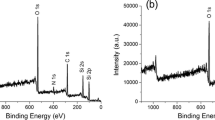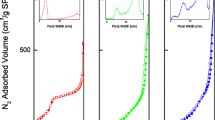Abstract
Here we report on the sol–gel synthesis of porous inorganic materials based on manganese, molybdenum, and tungsten compounds using the “core–shell” siloxane-acrylate latex as a template. The chemical composition and structural characteristics of the materials obtained have been investigated. It was shown that temperature conditions and gaseous media composition during the template destruction controlled the composition and structure of porous materials. To obtain porous inorganic materials for catalytic applications, the “core–shell” latex template was preliminarily functionalized by gold and palladium nanoparticles obtained by thermal reduction of noble metal ions-precursors in a polycarboxylic “shell”. Upon the template removal, noble metals nanoparticles of a size of dozens of nanometers were homogeneously distributed in the material porous structure. The evaluation of the catalytic activity of macroporous manganese, tungsten, and molybdenum oxides under the conditions of liquid phase catalytic oxidation of organic dyes has been performed. The prospects of employing macroporous oxide systems with immobilized nanoparticles of noble metals in the processes of hydrothermal oxidation of radionuclide organic complexes in radioactive waste decontamination have been demonstrated.













Similar content being viewed by others
References
Wang W, Pang Y, Hodgson SNB (2009) XRD studies of thermally stable mesoporous tungsten oxide synthesized by a template sol–gel process from tungstic acid precursor. Micro Meso Mater 121:121–128
Sadakane M, Sasaki K, Kunioku H, Ohtani B, Abe R, Ueda W (2010) J Mater Chem 20:1811–1818
Zhao DY, Huo QS, Feng JL, Chmelka BF, Stucky GD (1998) Nonionic triblock and star diblock copolymer and oligomeric surfactant syntheses of highly ordered, hydrothermally stable, mesoporous silica structures. JACS 120(24):6024–6036
Chain F, Tan R, Cao F, Zhai F, Wang X, Shao C, Liu Y (2007) Dendric and tubular tungsten oxide by surface sol–gel mineralization of cellulosic substance. Mater Lett 61:3939–3941
Partap S, Hebb AK, Rehman IU, Darr JA (2007) Formation of porous natural-synthetic polymer composites using emulsion templating and supercritical fluid assisted impregnation. Polym Bull 58(5/6):849–860
Liew M, Hoa K, Lu M, Zhang Y (2006) Preparation of porous materials with ordered hole structure. Adv Colloid Interface Sci 121:9–23
Steinhart M (2008) Supramolecular organization of polymeric materials in nanoporous hard templates. Adv Polym Sci 220:123–187
Huo Q, Margolese DI, Ciesla U, Demuth DG, Feng P, Gier TE, Sieger P, Firouzi A, Chmelka BF, Schuth F, Stucky GD (1994) Organization of organic molecules with inorganic molecular species into nanocomposite biphase arrays. Chem Mater 6:1176–1191
Colombo P, Vakifahmetoglu C, Costacurta S (2010) Fabrication of ceramic components with hierarchical porosity. J Mater Sci 45:5425–5455
Holland BT, Blanford CF, Do T, Stein A (1999) Synthesis of highly ordered, three-dimensional, macroporous structures of amorphous or crystalline inorganic oxides, phosphates, and hybride composites. Chem Mater 11:795–805
Carbajo MC, Gomez A, Torralvo MJ, Encisco E (2002) Macroporous silica and titania obtained using poly[styrene-co-(2-hydroxyethyl methacrylate) as template. J Mater Chem 12:2740–2746
Verissima C, Alves OL (2006) Microstructural modifications in macroporous oxides prepared via latex templating: synthesis and thermal stability of porous microstructure. J Ceram Soc 89(7):2226–2231
Ghorai TK, Pramanik S, Pramanik P (2009) Synthesis and photocatalytic oxidation of different organic dyes by using Mn2O3/TiO2 solid solution and visible light. Appl Surf Sci 255(22):9026–9031
Santos VP, Carabineiro SAC, Tavares PB, Pereira MFR, Órfão JJM, Figueiredo JL (2010) Oxidation of CO, ethanol and toluene over TiO2 supported noble metal catalysts. Appl Catal B Environ 99:198–205
Zhang X, Shi H, Xu B (2007) Comparative study of Au/ZrO2 catalysts in CO oxidation and 1,3-butadiene hydrogenation. Catal Today 122:330–337
Zaki MI, Hasan MA, Pasupulety L (2000) Influence of CuOx additives on CO oxidation activity and related surface and bulk behaviours of Mn2O3, Cr2O3 and WO3 catalysts. Appl Catal A Gen 198(1–2):247–259
Mizushima T, Moriya Y, Huu N, Phuc H, Ohkita H, Kakuta N (2011) Soft chemical transformation of α-MoO3 to β-MoO3 as a catalyst for vapor-phase oxidation of methanol. Catal Commun 13(1):10–13
Wang LC, Huang XS, Liu Q, Liu YM, He YC, He Y, Fan KN, Zhuang SH (2008) Gold nanoparticles deposited on manganese(III) oxide as novel efficient catalyst for low temperature CO oxidation. J Catal 259(1):66–74
Massah AR, Kalbasi RJ, Azadi M (2012) Highly selective oxidation of alcohols using MnO2/TiO2–ZrO2 as a novel heterogeneous catalyst. C R Chim 15:428–436
Navio JA, Colón G (1994) Heterogeneous photocatalytic oxidation of liquid isopropanol by TiO2, ZrO2 and ZrTiO4 powders. Stud Surf Sci Catal 82:721–728
Yang XL, Dai WL, Guo C, Chen H, Cao Y, Li H, He H, Fan K (2005) Synthesis of novel core–shell structured WO3/TiO2 spheroids and its application in the catalytic oxidation of cyclopentene to glutaraldehyde by aqueous H2O2. J Catal 234(2):438–450
Trach Y, Schulze B, Makota O, Bulgakova L (2006) The liquid-phase oxidation of olefins by molecular oxygen in the presence of metal borides and MoO3. J Mol Catal A Chem 258(1–2):292–294
Avramenko VA, Bratskaya SYu, Voit AV, Dobrzhanskiy VG, Egorin AM, Zadorozhniy PA, Mayorov VYu, Sergienko VI (2010) Implementation of the continuous-flow hydrothermal technology of the treatment of concentrated liquid radioactive wastesat nuclear power plants. Theor Found Chem Eng 44(4):592–599
Avramenko VA, Bratskaya SY, Karpov PA, Mayorov VYu, Mironenko AY, Palamarchuk MS, Sergienko VI (2010) Macroporous catalysts for liquid-phase oxidation on the basis of manganese oxides containing gold nanoparticles. Dokl Phys Chem 435:193–197
Wang HH, Li XR, Fei GO, Mou J (2010) Synthesis, morphology and rheology of core–shell silicone acrylic emulsion stabilized with polymerisable surfactant. Express Polym Lett 4(11):670–680
Studart AR, Gonzenbach UT, Tervoort E, Gauckler LJ (2006) Processing routes to macroporous ceramics. J Am Ceram Soc 89(6):1771–1789
Kovalenko AS, Ilin VG, Filippov OP (1997) Mesoporous molecular sieves and nanoperiodic materials. Theor Exp Chem 33(5):322–337 [in Russian]
Avramenko VA, Bratskaya SYu, Egorin AM, Markovtseva TG, Ryabushkin AN, Harjula R (2008) Nanosized latexes containing polyacrylic acid and their role in migration and fixation of radionuclides at facilities of nuclear power plants. Probl Rad Saf 4:23–29 [in Russian]
Taniguchi T, Inada T, Kashiwakura T, Murakami F, Kohri M, Nakahira T (2011) Preparation of polymer core–shell particles supporting gold nanoparticles. Colloid Surf A Phys Eng Asp 377:63–69
Isaeva EI, Boitsova TB, Gorbunova VV (2006) Photochemical synthesis of gold nanoparticles in latexes. Rus J Appl Chem 79(4):674–676
Koetz J, Kosmella S (2007) Polyelectrolytes and nanoparticles. Springer, New York
Yakimovich NO, Sapogova NV, Smirnova LA, Aleksandrov AP, Gracheva TA, Kirsanov AV, Bityurin NM (2008) Gold-containing nanocomposition materials on the basis of homo-and copolymers of methylmethacrylate. Rus J Phys Chem 2(1):128–134
Hench LL, West K (1990) The sol–gel process. Chem Rev 90(1):33–72
Maksimov AI, Moshnikov VA, Tairov YUM, Shilova OA (2007) Fundamentals of sol–gel synthesis. Elmor JSC Technomedia, Sant-Petersburg [in Russian]
Petrov VV, Plugotarenko NK, Korolev AN, Nazarova TN (2011) Technology of formation of nanocomposite materials by sol–gel method. TGI YaFU, Taganrog [in Russian] (translation to English is South Federal University, Institute of Technology)
Zelikman AN, Nikitin LS (1978) Tungsten. Metallurgy, Moscow [in Russian]
Zelikman AN (1970) Molybdenum. Metallurgy, Moscow [in Russian]
Greenwood NN, Earnshaw A (1997) Chemistry of the elements, 2nd edn. Elsevier, Amsterdam
Conte V, Difuria F, Moro S (1996) The versatile chemistry of peroxo complexes of vanadium, molybdenum and as oxidants of organic compounds. J Phys Org Chem 9:329–336
Brauer G (1985) Handbook on inorganic synthesis, 5th edn. Mir, Moscow
Castro CS, Guerreiro MC, Oliveira LCA, Gonçalves M, Anastácio AS, Nazzarro M (2009) Iron oxide dispersed over activated carbon: support influence on the oxidation of the model molecule methylene blue. Appl Catal A Gen 367:53–58
Worl LA, Buelow SJ, Padilla D (2000) Hydrothermal processing. Chall Plutonium Sci Los Alamos Sci 26:450
Author information
Authors and Affiliations
Corresponding author
Rights and permissions
About this article
Cite this article
Papynov, E.K., Mayorov, V.Y., Palamarchuk, M.S. et al. Sol–gel synthesis of porous inorganic materials using “core–shell” latex particles as templates. J Sol-Gel Sci Technol 68, 374–386 (2013). https://doi.org/10.1007/s10971-013-3039-0
Received:
Accepted:
Published:
Issue Date:
DOI: https://doi.org/10.1007/s10971-013-3039-0




